Input interpretation

2, 2-dimethylpropane
Chemical names and formulas

formula | C_5H_12 name | 2, 2-dimethylpropane alternate names | 1, 1, 1-trimethylethane | neopentane | propane, 2, 2-dimethyl- | tert-pentane mass fractions | C (carbon) 83.2% | H (hydrogen) 16.8%
Lewis structure
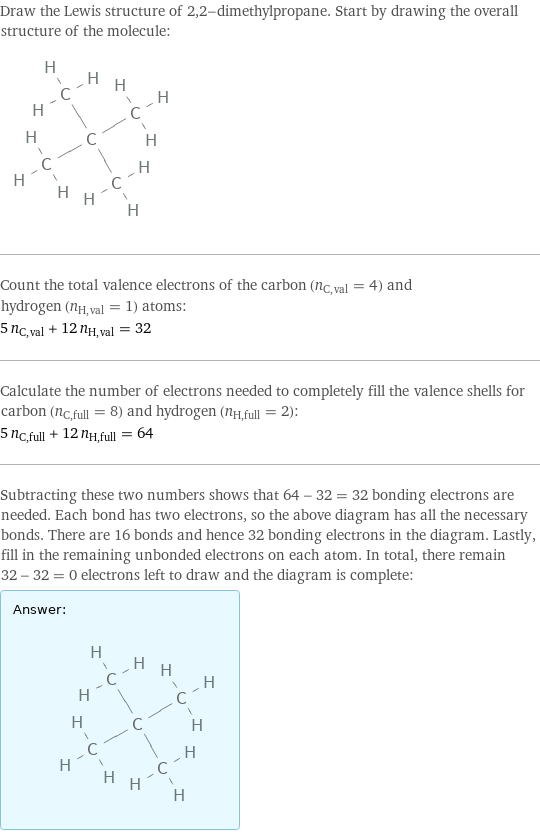
Draw the Lewis structure of 2, 2-dimethylpropane. Start by drawing the overall structure of the molecule: Count the total valence electrons of the carbon (n_C, val = 4) and hydrogen (n_H, val = 1) atoms: 5 n_C, val + 12 n_H, val = 32 Calculate the number of electrons needed to completely fill the valence shells for carbon (n_C, full = 8) and hydrogen (n_H, full = 2): 5 n_C, full + 12 n_H, full = 64 Subtracting these two numbers shows that 64 - 32 = 32 bonding electrons are needed. Each bond has two electrons, so the above diagram has all the necessary bonds. There are 16 bonds and hence 32 bonding electrons in the diagram. Lastly, fill in the remaining unbonded electrons on each atom. In total, there remain 32 - 32 = 0 electrons left to draw and the diagram is complete: Answer: | |
3D structure

3D structure
Basic properties
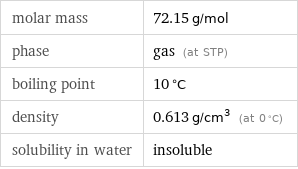
molar mass | 72.15 g/mol phase | gas (at STP) boiling point | 10 °C density | 0.613 g/cm^3 (at 0 °C) solubility in water | insoluble
Units

Gas properties (at STP)

density | 0.613 g/cm^3 (at 0 °C) vapor density | 2.5 (relative to air) molar volume | 118 cm^3/mol refractive index | 1.3476 dynamic viscosity | 7.259×10^-6 Pa s (at 25 °C)
Units

Thermodynamic properties
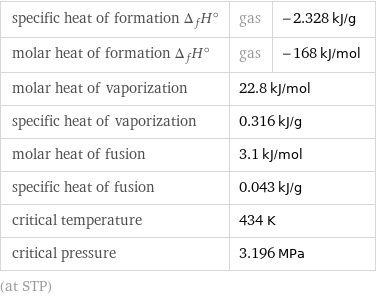
specific heat of formation Δ_fH° | gas | -2.328 kJ/g molar heat of formation Δ_fH° | gas | -168 kJ/mol molar heat of vaporization | 22.8 kJ/mol | specific heat of vaporization | 0.316 kJ/g | molar heat of fusion | 3.1 kJ/mol | specific heat of fusion | 0.043 kJ/g | critical temperature | 434 K | critical pressure | 3.196 MPa | (at STP)
Phase diagram
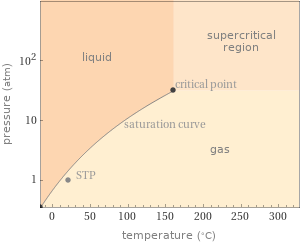
Phase diagram
Units

Chemical identifiers
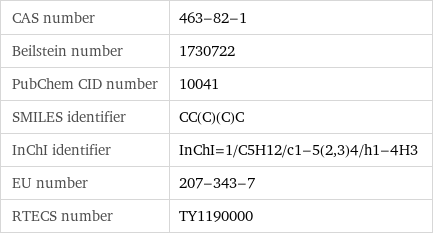
CAS number | 463-82-1 Beilstein number | 1730722 PubChem CID number | 10041 SMILES identifier | CC(C)(C)C InChI identifier | InChI=1/C5H12/c1-5(2, 3)4/h1-4H3 EU number | 207-343-7 RTECS number | TY1190000
NFPA label

NFPA label

NFPA health rating | 2 NFPA fire rating | 4 NFPA reactivity rating | 0
Safety properties
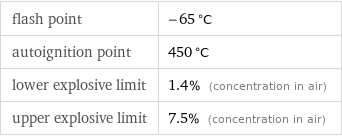
flash point | -65 °C autoignition point | 450 °C lower explosive limit | 1.4% (concentration in air) upper explosive limit | 7.5% (concentration in air)

DOT hazard class | 2.1 DOT numbers | 2044
Toxicity properties

RTECS classes | other